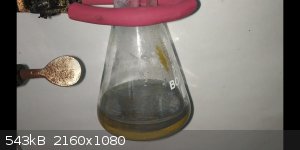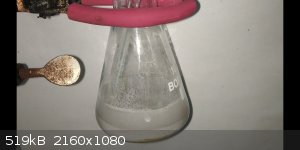vibbzlab
Hazard to Others
  
Posts: 241
Registered: 6-11-2019
Member Is Offline
Mood: Always curious
|
|
Help in Identifying a compound
hello everyone
I was trying to make Mercury II Chloride.
I took mercury metal and dissolved in nitric acid.
I then precipitated out the oxide by adding sodium hydroxide. the yellow orange colored mercury II oxide precipitated out. I then washed that
precipitated couple of times with water to remove all the sodium hydroxide. after that I added concentrated HCl to it. But I got a grey colored powder
that is insoluble in water. Was that merucry I oxide. if so how was thayt produced. I then added a little hydrogen peroxide and heated the solution.
So everythhing got dissolved and i could boil the solution down and i got mercuric II chloride crystals.
I am really in doubt about that grey compound.Can anyone explain
[Edited on 12-6-2020 by vibbzlab]
 
Amateur chemist. Doctor by profession
Have a small cute home chemistry lab.

Please do check out my lab in YouTube link below
This is my YouTube channel |
|
|
Eddie Current
Hazard to Self
 
Posts: 78
Registered: 25-7-2018
Member Is Offline
|
|
How strong was your starting HNO3?
I'm not sure what route you are utilising but:
Hg + 4HNO3(heat) --> Hg(NO3)2
Hg(NO3)2 + 4HCl -->HgCl2
Be careful with these reactions.
|
|
|
vibbzlab
Hazard to Others
  
Posts: 241
Registered: 6-11-2019
Member Is Offline
Mood: Always curious
|
|
I used concentrates HNO3 70%
and 37% HCl
Amateur chemist. Doctor by profession
Have a small cute home chemistry lab.

Please do check out my lab in YouTube link below
This is my YouTube channel |
|
|
mackolol
Hazard to Others
  
Posts: 458
Registered: 26-10-2017
Member Is Offline
Mood: Funky
|
|
Quote: Originally posted by Eddie Current  | How strong was your starting HNO3?
I'm not sure what route you are utilising but:
Hg + 4HNO3(heat) --> Hg(NO3)2
Hg(NO3)2 + 4HCl -->HgCl2
Be careful with these reactions.
|
Addition of HCl to Mercury Nitrate doesn't create Mercury Chloride. HCl isn't able to displace HNO3 in salts.
And with this gray powder, it's probably mercury oxide, but you have to heat it up I guess, because oxides don't react so vigorously if even at all
with acids at room temp.
But adding H2O2 is also a good way, you should end up with HgCl2.
[Edited on 12-6-2020 by mackolol]
|
|
|
vibbzlab
Hazard to Others
  
Posts: 241
Registered: 6-11-2019
Member Is Offline
Mood: Always curious
|
|
yup I added sodium hydroxide to precipitate out mercury II oxide which has that yellow orange color. I then washed it multiple times to remove all the
excess alkali and then added hcl to the oxide. but i got this grey ppt. I wonder how mercury I oxide was formed
Amateur chemist. Doctor by profession
Have a small cute home chemistry lab.

Please do check out my lab in YouTube link below
This is my YouTube channel |
|
|
unionised
International Hazard
    
Posts: 5102
Registered: 1-11-2003
Location: UK
Member Is Offline
Mood: No Mood
|
|
If you didn't add enough nitric acid then the solution will have contained Hg+ and Hg++
Adding base will have produced a mess of mercury and it's oxides, but if there was HgO present it would have been more or less the right colour.
Adding HCl will have dissolved the HgO and left HgCl and Hg metal- which will be grey.
|
|
|
Bedlasky
International Hazard
    
Posts: 1219
Registered: 15-4-2019
Location: Period 5, group 6
Member Is Offline
Mood: Volatile
|
|
Quote: Originally posted by mackolol  |
Addition of HCl to Mercury Nitrate doesn't create Mercury Chloride. HCl isn't able to displace HNO3 in salts.
[Edited on 12-6-2020 by mackolol] |
Why not? HgCl2 is far less soluble than Hg(NO3)2.
Btw. - Does H2O2+HCl dissolve mercury? Grey precipitate over orange looks like mercury but I am not sure if dissolving of mercury is that easy.
[Edited on 12-6-2020 by Bedlasky]
|
|
|
Boffis
International Hazard
    
Posts: 1836
Registered: 1-5-2011
Member Is Offline
Mood: No Mood
|
|
Quote: Originally posted by mackolol  | Quote: Originally posted by Eddie Current  | How strong was your starting HNO3?
I'm not sure what route you are utilising but:
Hg + 4HNO3(heat) --> Hg(NO3)2
Hg(NO3)2 + 4HCl -->HgCl2
Be careful with these reactions.
|
Addition of HCl to Mercury Nitrate doesn't create Mercury Chloride. HCl isn't able to displace HNO3 in salts.
And with this gray powder, it's probably mercury oxide, but you have to heat it up I guess, because oxides don't react so vigorously if even at all
with acids at room temp.
But adding H2O2 is also a good way, you should end up with HgCl2.
[Edited on 12-6-2020 by mackolol] |
Not true. A very curious feature of mercuric chloride is the fact that it is almost un-ionised in aqueous solution unlike mercuric nitate. You don't
even need HCl, sodium chloride solution will do just as well. So as long as you exceed the solubility of mercuric chloride in whatever your medium is
it will crystallise out. The solubility of mercuric chloride is low (c 5 to 6g per 100ml at RT) while that of the nitrate is extremely high
>300g/100ml of water. So you while ppt mercuric chloride by simply adding a chloride ion source. The problem of trying to dissolve HgO in
hydrochloric acid it just this low overal solubility so the acid need to be very dilute. In fact the formation of mercuric chloride when chloride ions
are added to mercuric nitrate solution is the basis of a simple method of analysis chloride ions, diphenylcarbazide is added as an indicator and when
the chloride ion concentration reaches that of the Hg in solution they proceed to decolourise the purple carbazide complex.
However, looking at the OP's picture of his mercury oxide it is clearly not pure Hg II oxide (brilliant orange to cadmium yellow colour). Hg2O2 tends
to disproportionate into finely divided mercury and HgO giving the ppt a greenish grey tinge, as seen in the OP's photograph.
|
|
|
vibbzlab
Hazard to Others
  
Posts: 241
Registered: 6-11-2019
Member Is Offline
Mood: Always curious
|
|
Oh thankyou for the replies. But adding that hydrogen peroxide really did the thing.
Amateur chemist. Doctor by profession
Have a small cute home chemistry lab.

Please do check out my lab in YouTube link below
This is my YouTube channel |
|
|